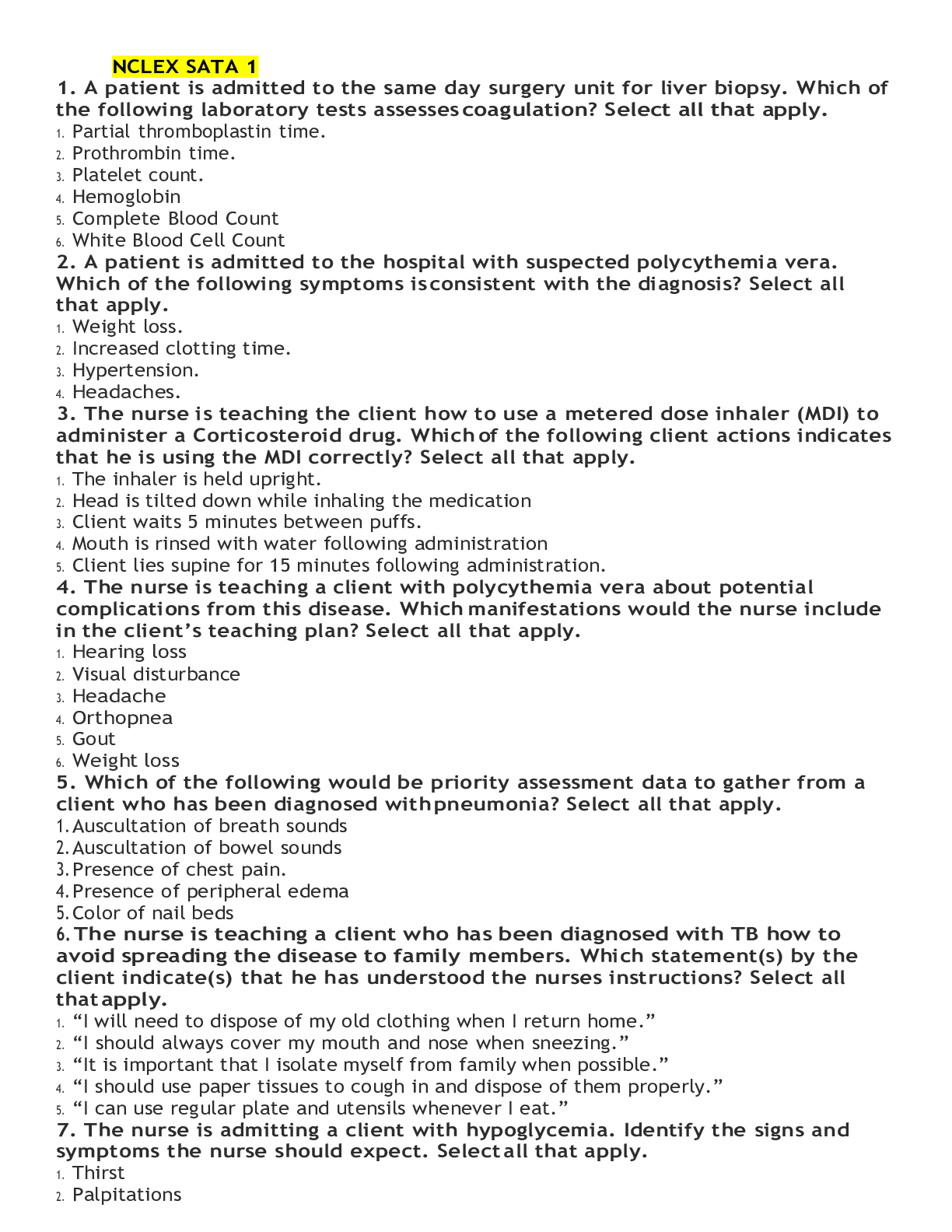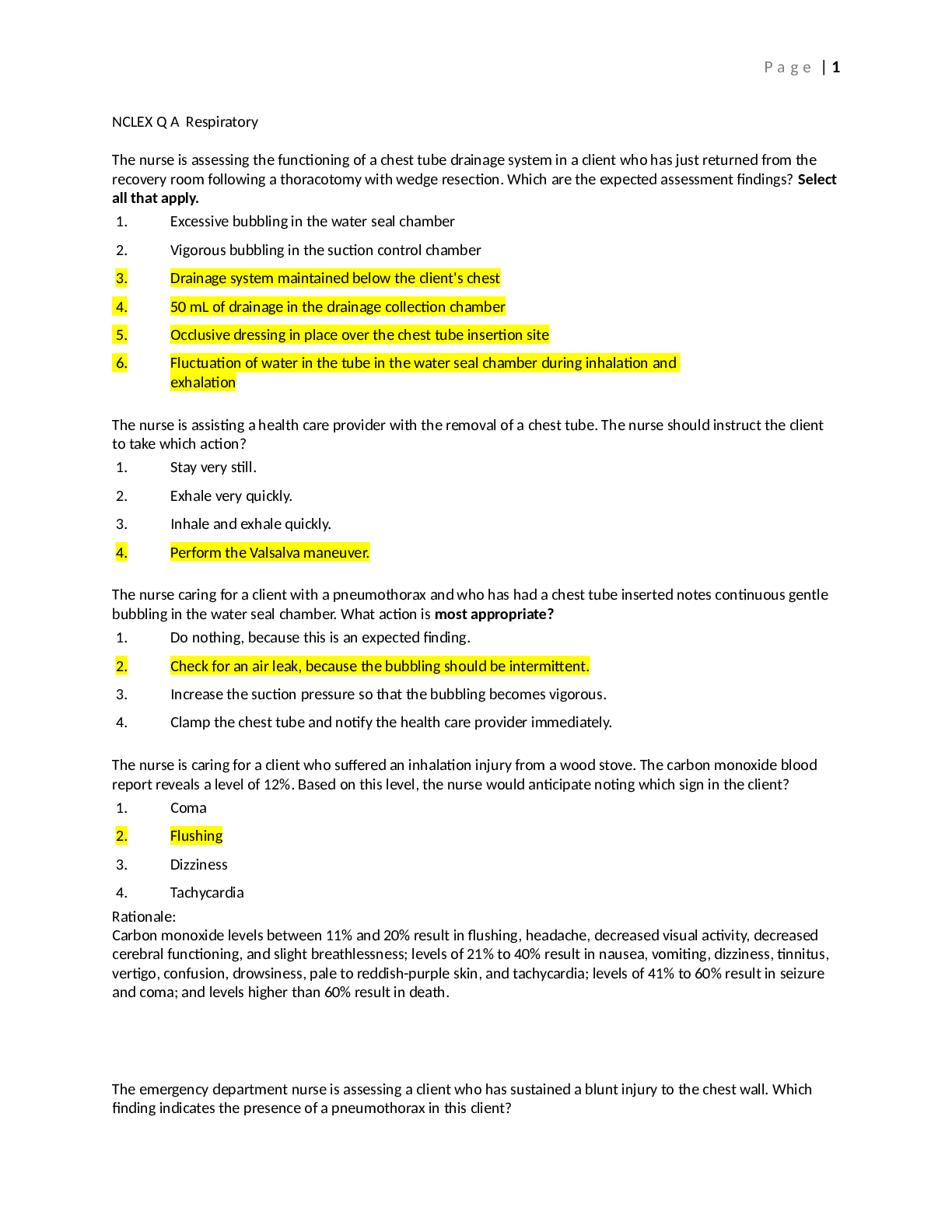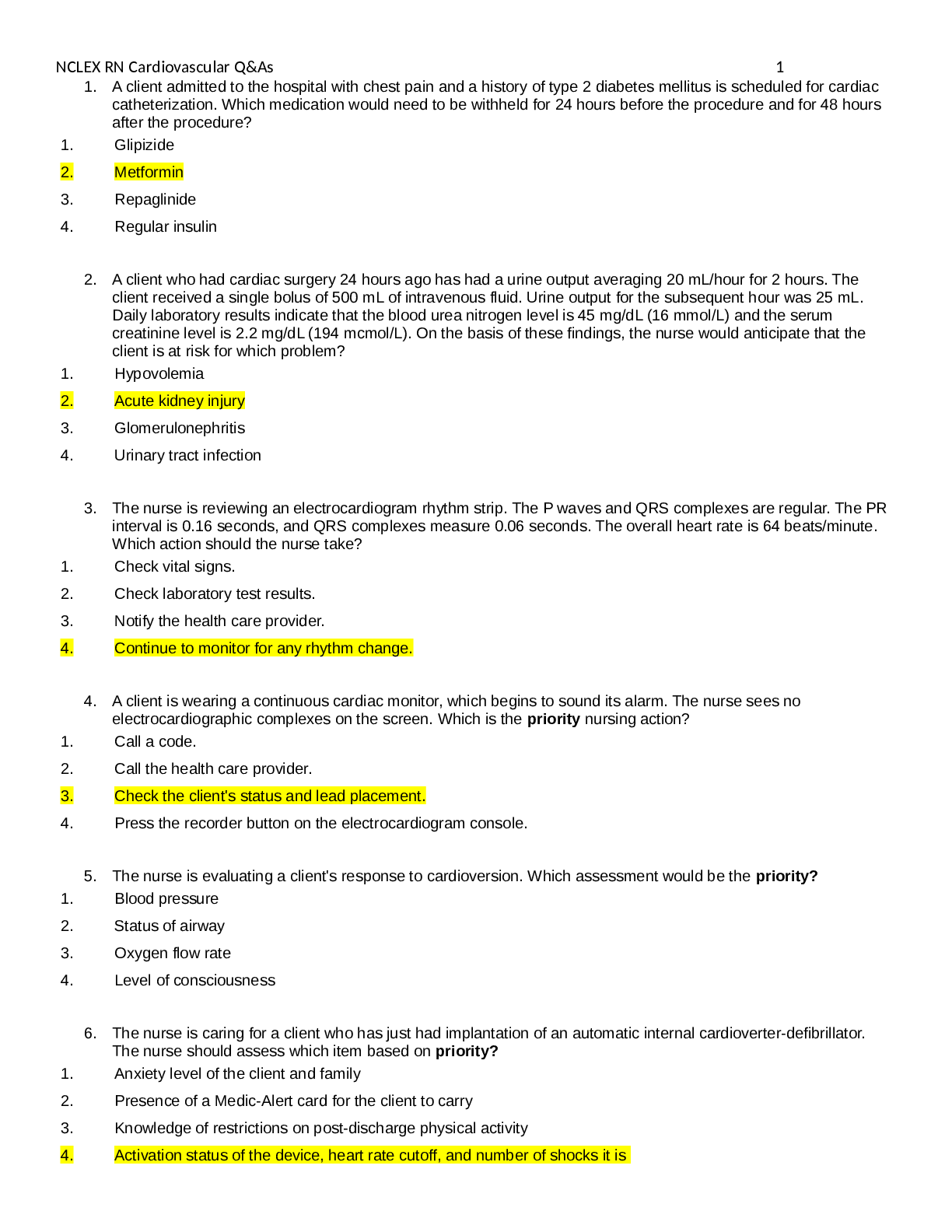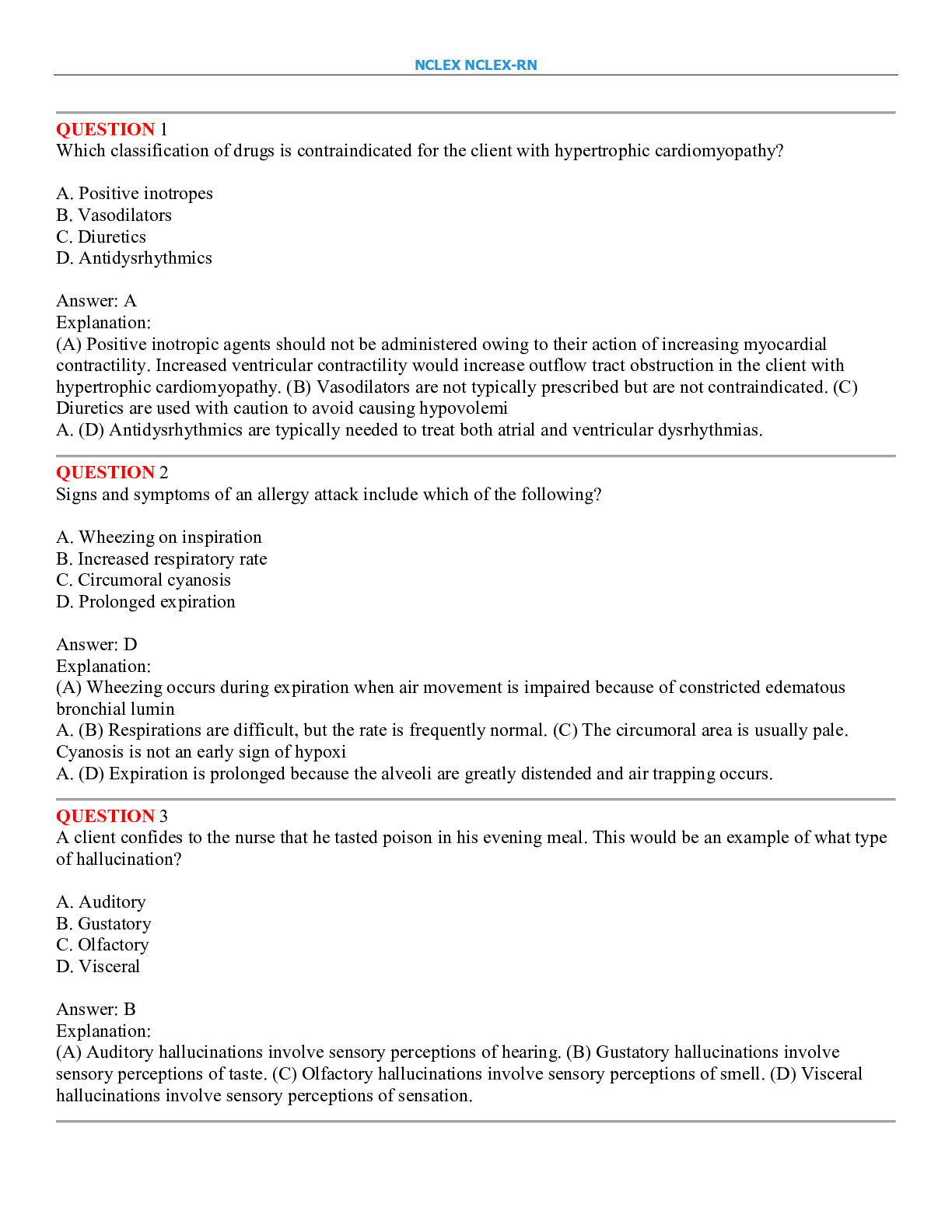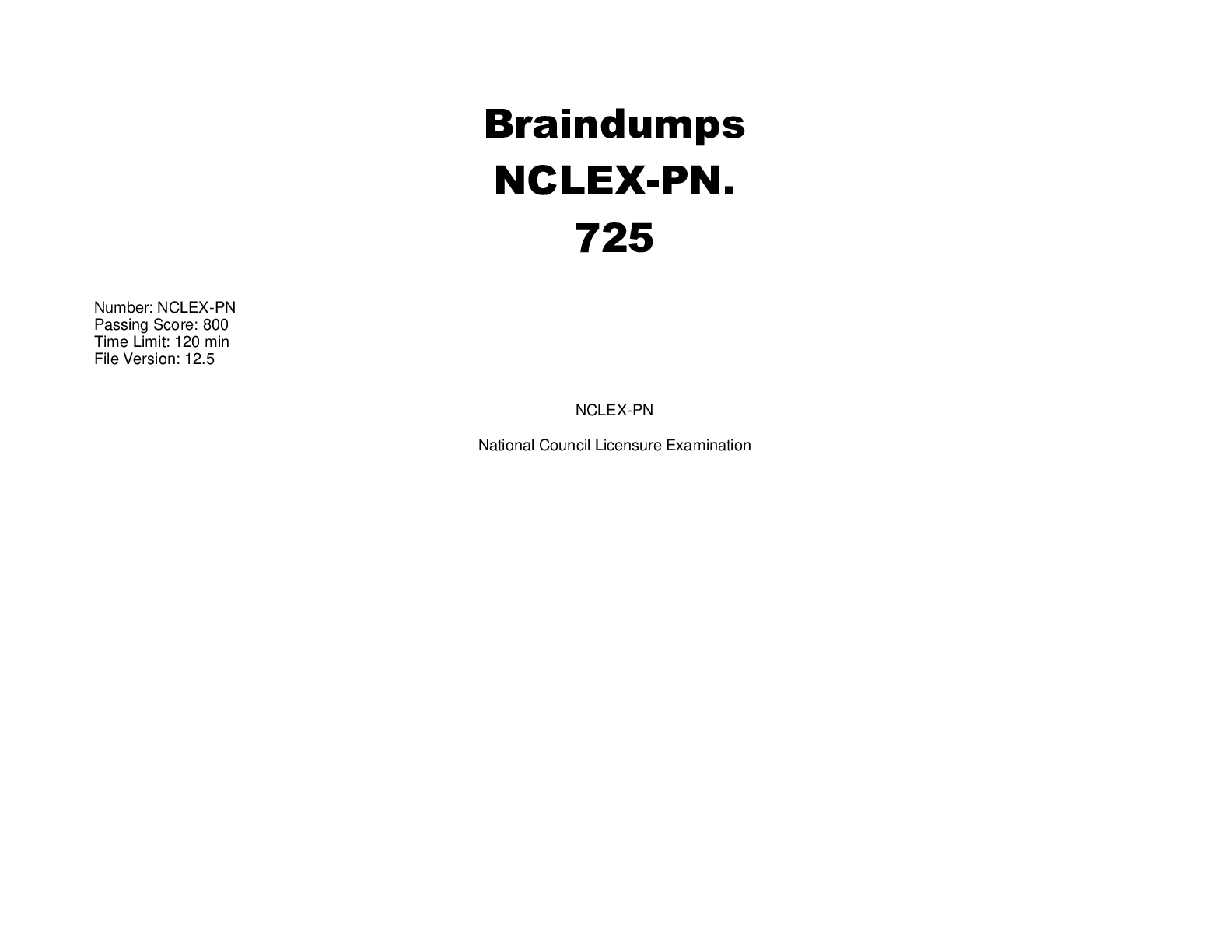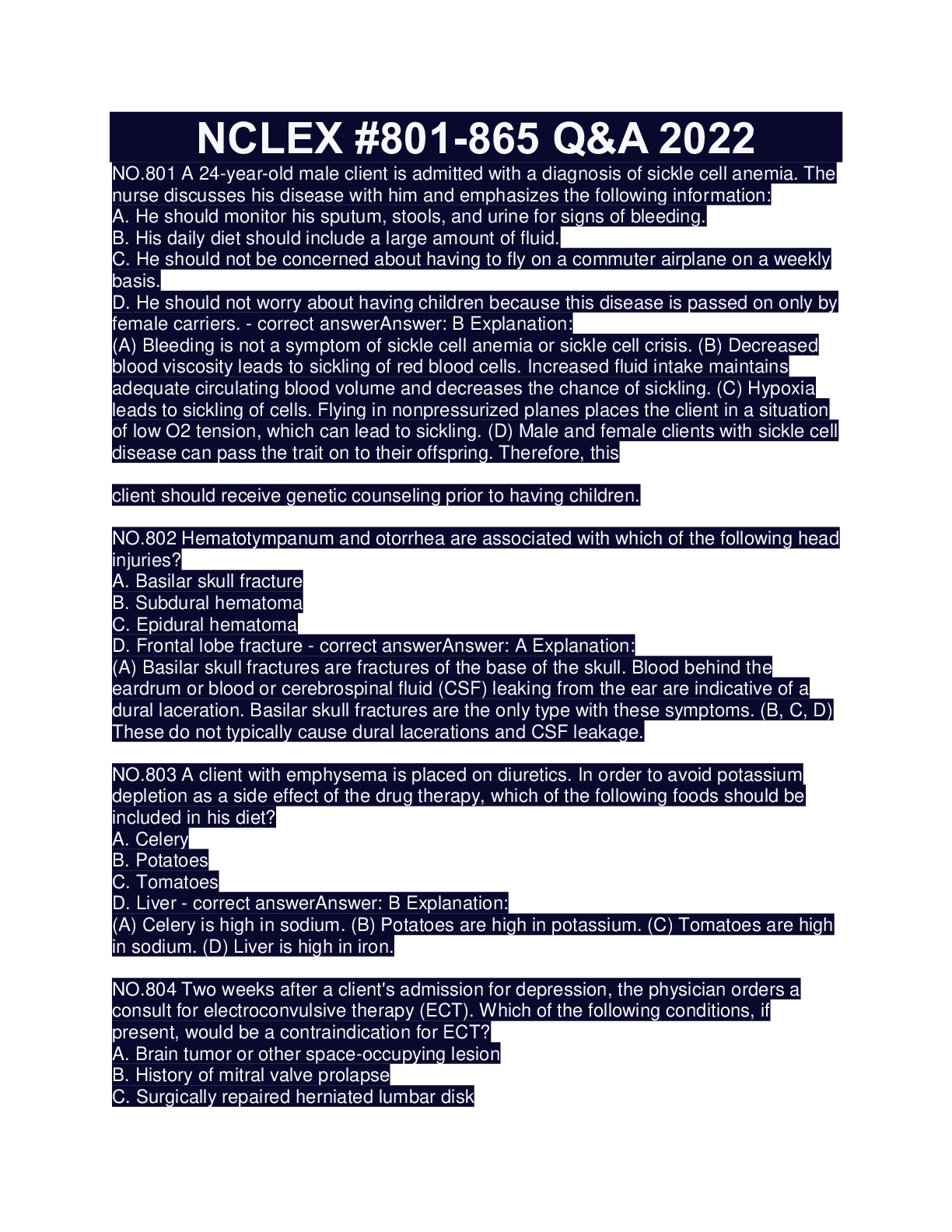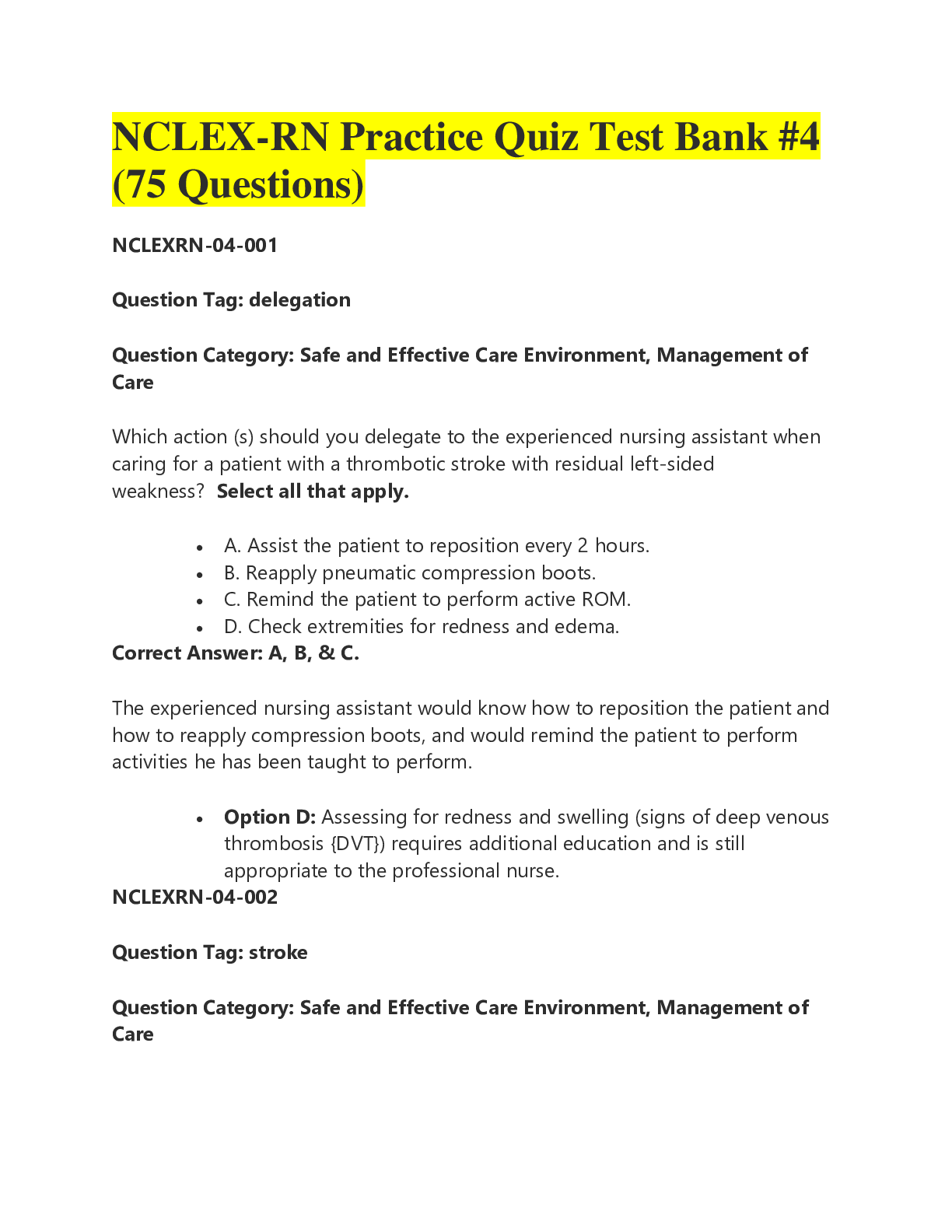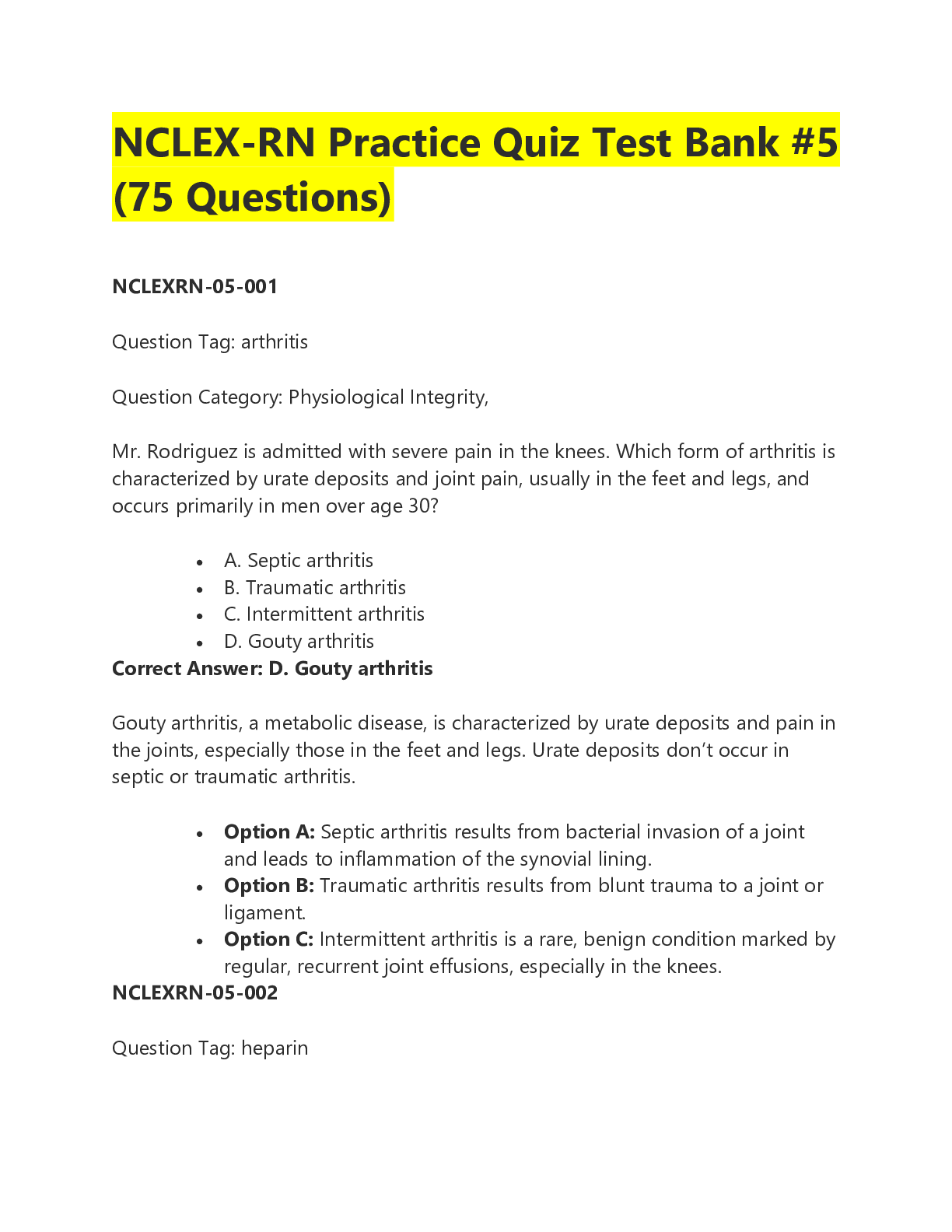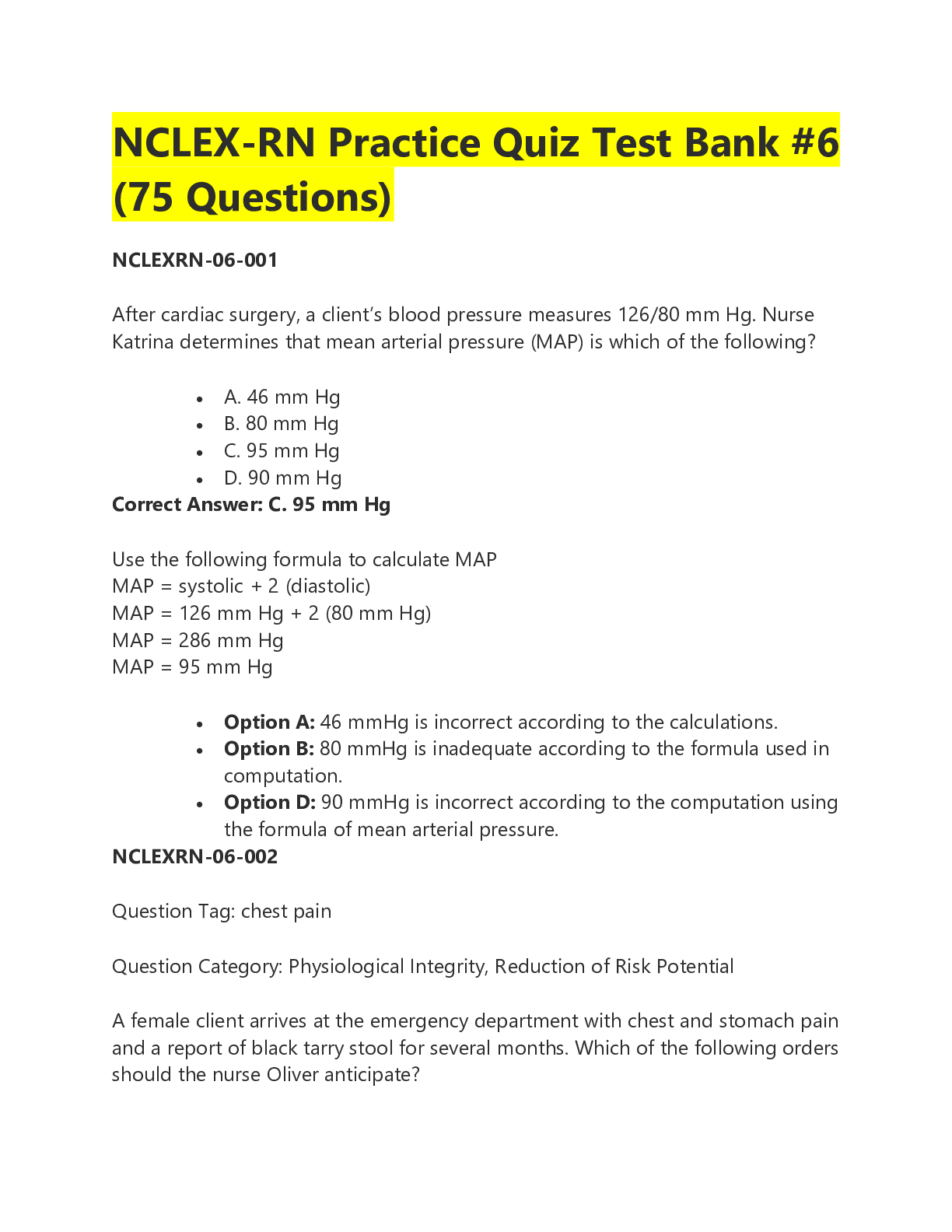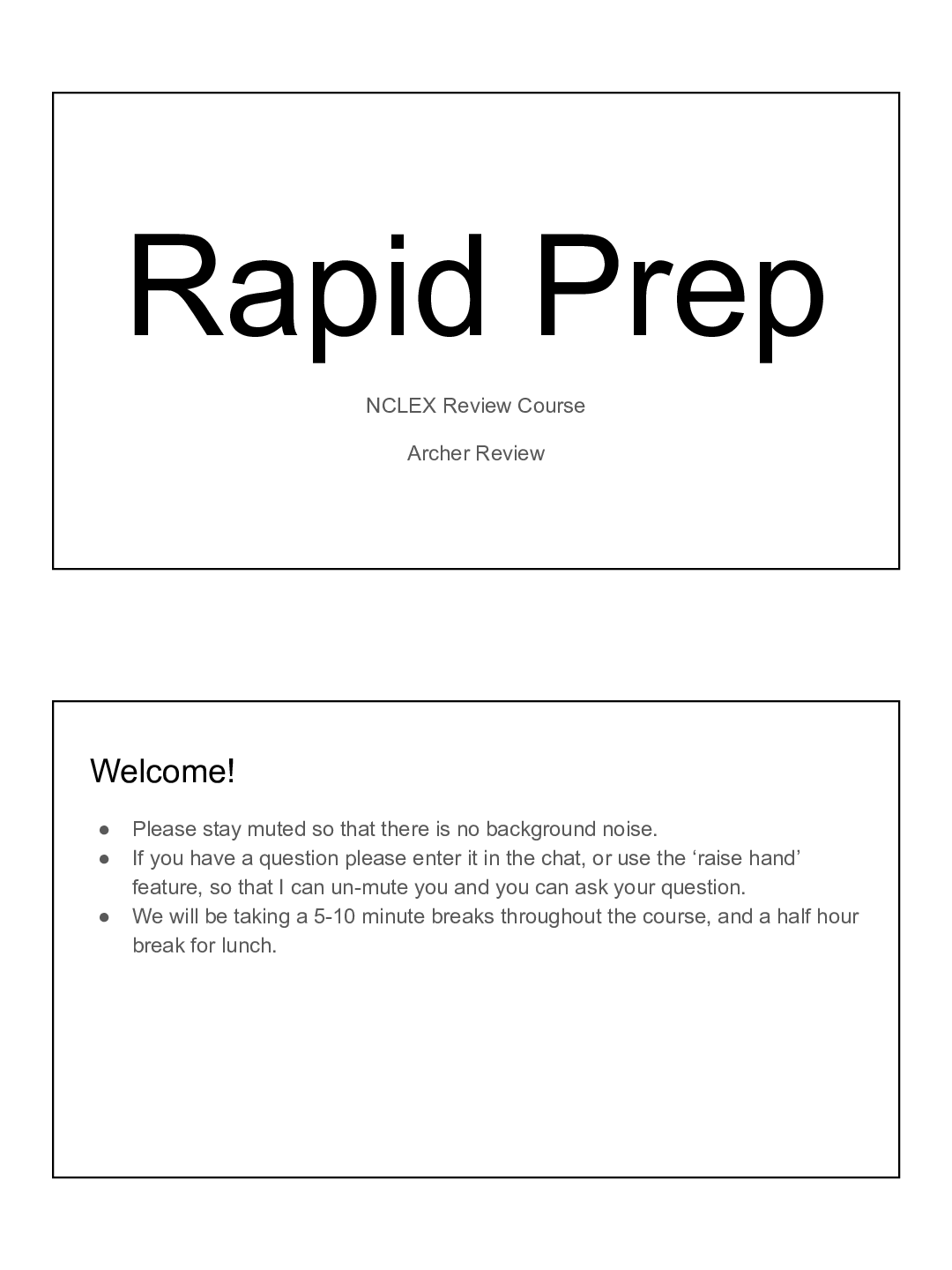NCLEX-RN Practice Quiz Test Bank #3 (75 Questions)
Document Content and Description Below
NCLEX-RN Practice Quiz Test Bank #3 (75 Questions) 1. 1. Question A patient with Parkinson’s disease has a nursing diagnosis of Impaired Physical Mobility related to neuromuscular impairment. You ob... serve a nursing assistant performing all of these actions. For which action must you intervene? o A. The NA assists the patient to ambulate to the bathroom and back to bed. o B. The NA reminds the patient not to look at his feet when he is walking. o C. The NA performs the patient’s complete bath and oral care. o D. The NA sets up the patient’s tray and encourages the patient to feed himself. Incorrect Correct Answer: C. The NA performs the patient’s complete bath and oral care. The nursing assistant should assist the patient with morning care as needed, but the goal is to keep this patient as independent and mobile as possible. • Option A: Assisting the patient to ambulate prevents incidences of fall and injury. • Option B: Reminding the patient not to look at his feet while walking maintains the client’s independence while keeping him safe. • Option D: Encouraging the patient to feed himself is an appropriate goal of maintaining independence. 2. 2. Question The nurse is preparing to discharge a patient with chronic low back pain. Which statement by the patient indicates that additional teaching is necessary? • A. “I will avoid exercise because the pain gets worse.” • B. “I will use heat or ice to help control the pain.” • C. “I will not wear high-heeled shoes at home or work.” • D. “I will purchase a firm mattress to replace my old one.” Incorrect Correct Answer: A. “I will avoid exercise because the pain gets worse.” Exercises are used to strengthen the back, relieve pressure on compressed nerves and protect the back from re-injury. Doing exercises to strengthen the lower back can help alleviate and prevent lower back pain. It can also strengthen the core, leg, and arm muscles. According to researchers, exercise also increases blood flow to the lower back area, which may reduce stiffness and speed up the healing process. • Option B: Ice and heat application are appropriate interventions for back pain. Applying ice or a reusable gel pack constricts blood vessels and reduces swelling around the injury. This is particularly useful for conditions, like a sprained ankle, that cause significant swelling. Heat has the opposite effect, increasing blood flow to the area. This relaxes muscle fibers, which can help when the client experiences spasms or stiffness. • Option C: People with chronic back pain should avoid wearing high-heeled shoes at all times. The normal s-curve of the spine acts as a cushion or spring, reducing stress on the vertebrae. When wearing high heels, the shape of the spine is altered and the client doesn’t get that same shock absorption as she walks, which, over time, can lead to uneven wear on the cartilage discs, joints and ligaments of the back. • Option D: A firm mattress prevents lower back pain. Sleeping on a mattress that is too firm can cause aches and pains on pressure points. A medium-firm mattress may be more comfortable because it allows the shoulder and hips to sink in slightly. Patients who want a firmer mattress for back support can get one with thicker padding for greater comfort. 3. 3. Question A patient with a spinal cord injury (SCI) complains about a severe throbbing headache that suddenly started a short time ago. Assessment of the patient reveals increased blood pressure (168/94) and decreased heart rate (48/minute), diaphoresis, and flushing of the face and neck. What action should you take first? • A. Administer the ordered acetaminophen (Tylenol). • B. Check the Foley tubing for kinks or obstruction. • C. Adjust the temperature in the patient’s room. • D. Notify the physician about the change in status. Incorrect Correct Answer: B. Check the Foley tubing for kinks or obstruction. These signs and symptoms are characteristic of autonomic dysreflexia, a neurologic emergency that must be promptly treated to prevent a hypertensive stroke. The cause of this syndrome is noxious stimuli, most often a distended bladder or constipation, so checking for poor catheter drainage, bladder distention, or fecal impaction is the first action that should be taken. • Option C: Adjusting the room temperature may be helpful, since too cool a temperature in the room may contribute to the problem. • Option A: Tylenol will not decrease the autonomic dysreflexia that is causing the patient’s headache. • Option D: Notification of the physician may be necessary if nursing actions do not resolve symptoms. 4. 4. Question Which patient should you, as charge nurse, assign to a new graduate RN who is orienting to the neurologic unit? • A. A 28-year-old newly admitted patient with spinal cord injury. • B. A 67-year-old patient with stroke 3 days ago and left-sided weakness. • C. An 85-year-old dementia patient to be transferred to long-term care today. • D. A 54-year-old patient with Parkinson’s who needs assistance with bathing. Incorrect Correct Answer: B. A 67-year-old patient with stroke 3 days ago and left-sided weakness. The new graduate RN who is oriented to the unit should be assigned stable, non-complex patients, such as the patient with stroke. • Option A: The newly admitted SCI should be assigned to experienced nurses. Most cases of SCI take place when trauma breaks and squeezes the vertebrae, or the bones of the back. This, in turn, damages the axons—the long nerve cell “wires” that pass through vertebrae, carrying signals between the brain and the rest of the body. The axons might be crushed or completely severed by this damage. Someone with injury to only a few axons might be able to recover completely from their injury. On the other hand, a person with damage to all axons will most likely be paralyzed in the areas below the injury. • Option C: A patient for transfer should be assigned to a nurse who has experience in the process of transferring patients. • Option D: The patient with Parkinson’s disease needs assistance with bathing, which is best delegated to the nursing assistant. 5. 5. Question A patient with a spinal cord injury at level C3-4 is being cared for in the ED. What is the priority assessment? • A. Determine the level at which the patient has intact sensation. • B. Assess the level at which the patient has retained mobility. • C. Check blood pressure and pulse for signs of spinal shock. • D. Monitor respiratory effort and oxygen saturation level. Incorrect Correct Answer: D. Monitor respiratory effort and oxygen saturation level. The first priority for the patient with an SCI is assessing respiratory patterns and ensuring an adequate airway. The patient with a high cervical injury is at risk for respiratory compromise because the spinal nerves (C3 – 5) innervate the phrenic nerve, which controls the diaphragm. • Option A: Determining this data can be done after addressing the concerns on the respiratory status of the patient. • Option B: This data can be assessed after monitoring the respiratory effort and oxygen saturation level of the patient. • Option C: Vital signs checking is also necessary, but not as high priority. Vital signs can be quite abnormal following SCI. In addition to the usual causes in trauma such as pain, bleeding, and distress, this can be due to loss of autonomic control, which occurs particularly in cervical or high thoracic injuries. The autonomic nervous system controls our HR, BP temperature, etc. Autonomic instability is most acute in the first few days to weeks of the injury. 6. 6. Question You are pulled from the ED to the neurologic floor. Which action should you delegate to the nursing assistant when providing nursing care for a patient with SCI? • A. Assess the patient's respiratory status every 4 hours. • B. Take the patient’s vital signs and record them every 4 hours. • C. Monitor nutritional status including calorie counts. • D. Have the patient turn, cough, and deep breathe every 3 hours. Incorrect Correct Answer: B. Take the patient’s vital signs and record them every 4 hours. The nursing assistant’s training and education include taking and recording the patient’s vital signs. • Option A: Assessing the patient’s respiratory status would require the knowledge of a registered nurse. • Option C: Monitoring patients requires additional education and is appropriate for the scope of practice for professional nurses. • Option D: The nursing assistant may assist with turning and repositioning the patient and may remind the patient to cough and deep breathe but does not teach the patient how to perform these actions. 7. 7. Question You are helping the patient with an SCI to establish a bladder-retraining program. What strategies may stimulate the patient to void? Select all that apply. • A. Stroke the patient’s inner thigh. • B. Pull on the patient’s pubic hair. • C. Initiate intermittent straight catheterization. • D. Pour warm water over the perineum. • E. Tap the bladder to stimulate detrusor muscle. Incorrect Correct Answers: A, B, D, & E All of the strategies, except straight catheterization, may stimulate voiding in patients with SCI. • Option C: Intermittent bladder catheterization can be used to empty the patient’s bladder, but it will not stimulate voiding. 8. 8. Question The patient with a cervical SCI has been placed in fixed skeletal traction with a halo fixation device. When caring for this patient the nurse may delegate which action (s) to the LPN/LVN? Select all that apply. • A. Check the patient’s skin for pressure from the device. • B. Assess the patient’s neurologic status for changes. • C. Observe the halo insertion sites for signs of infection. • D. Clean the halo insertion sites with hydrogen peroxide. Incorrect Correct Answer: A, C, & D • Option A: Checking for signs of pressure within the scope of practice of the LPN/LVN. • Option C: Observing for signs of an infection is within the scope of practice of the LPN/LVN. • Option D: The LPN/LVN also has the appropriate skills for cleaning the halo insertion sites with hydrogen peroxide. • Option B: Neurologic examination requires additional education and skill appropriate to the professional RN. 9. 9. Question You are preparing a nursing care plan for the patient with SCI including the nursing diagnosis Impaired Physical Mobility and Self-Care Deficit. The patient tells you, “I don’t know why we’re doing all this. My life’s over.” What additional nursing diagnosis takes priority based on this statement? • A. Risk for Injury related to altered mobility • B. Imbalanced Nutrition, Less Than Body Requirements • C. Impaired Adjustment to Spinal Cord Injury • D. Poor Body Image related to immobilization Incorrect Correct Answer: C. Impaired Adjustment to Spinal Cord Injury The patient’s statement indicates impairment of adjustment to the limitations of the injury and indicates the need for additional counseling, teaching, and support. • Option A: The patient may have a risk for injury due to SCI, but it is not related to the statement. The spinal cord can be injured by transection, distraction, compression, bruising, hemorrhage or ischemia of the cord or by injury to blood vessels supplying it. These injuries can all result in permanent cord injury and may be complete or incomplete. • Option B: A client with SCI may have imbalanced nutrition because of a [Show More]
Last updated: 8 months ago
Preview 1 out of 66 pages
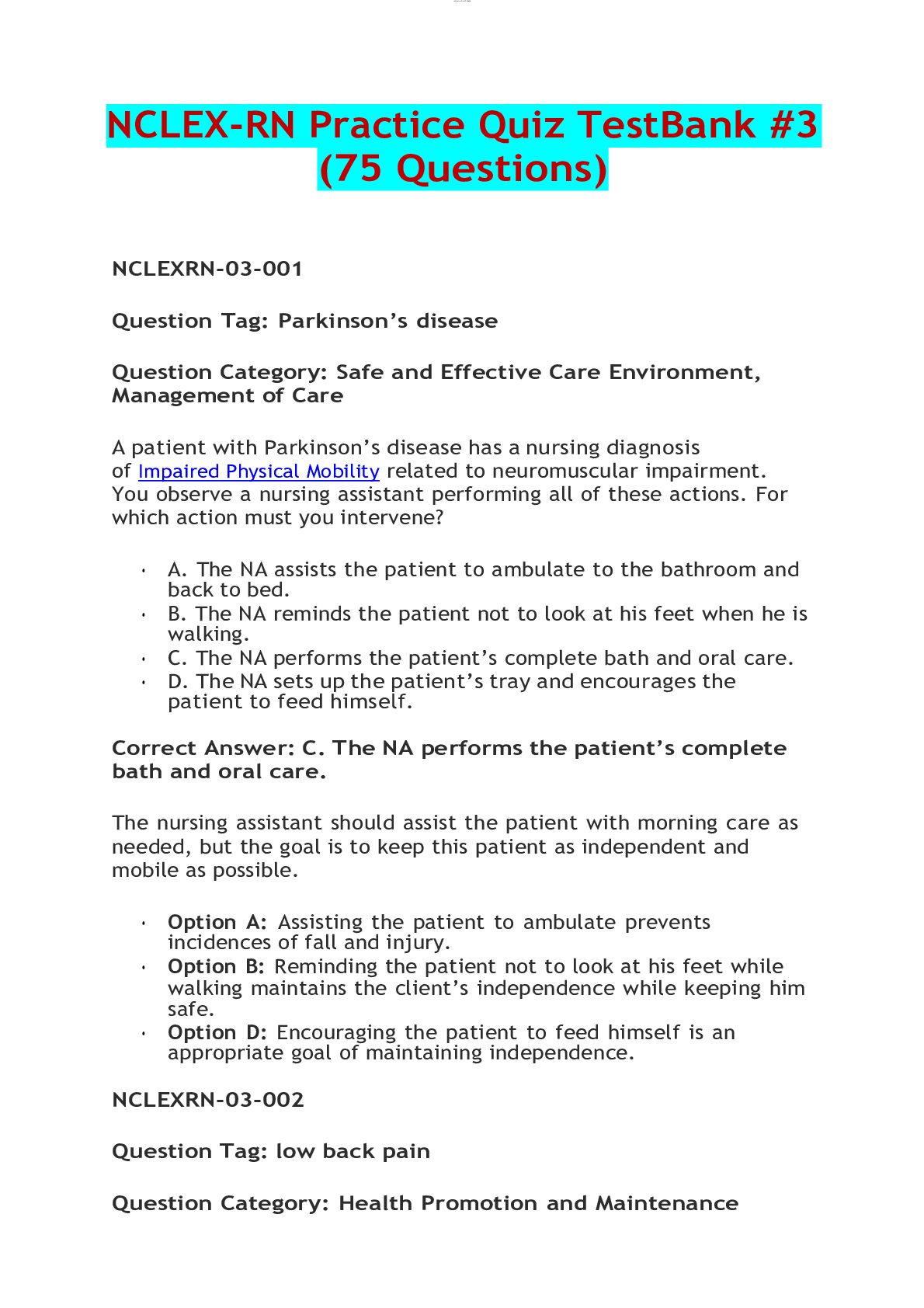
Buy this document to get the full access instantly
Instant Download Access after purchase
Add to cartInstant download
We Accept:

Also available in bundle (1)

NCLEX-RN Practice Quiz Test Bank SET 1-12 BUNDLE | (900 Questions in Total)
NCLEX-RN Practice Quiz Test Bank SET 1-12 BUNDLE | (900 Questions in Total)
By Ajay25 8 months ago
$50
12
Reviews( 0 )
$16.00
Document information
Connected school, study & course
About the document
Uploaded On
Oct 12, 2023
Number of pages
66
Written in
Additional information
This document has been written for:
Uploaded
Oct 12, 2023
Downloads
0
Views
47


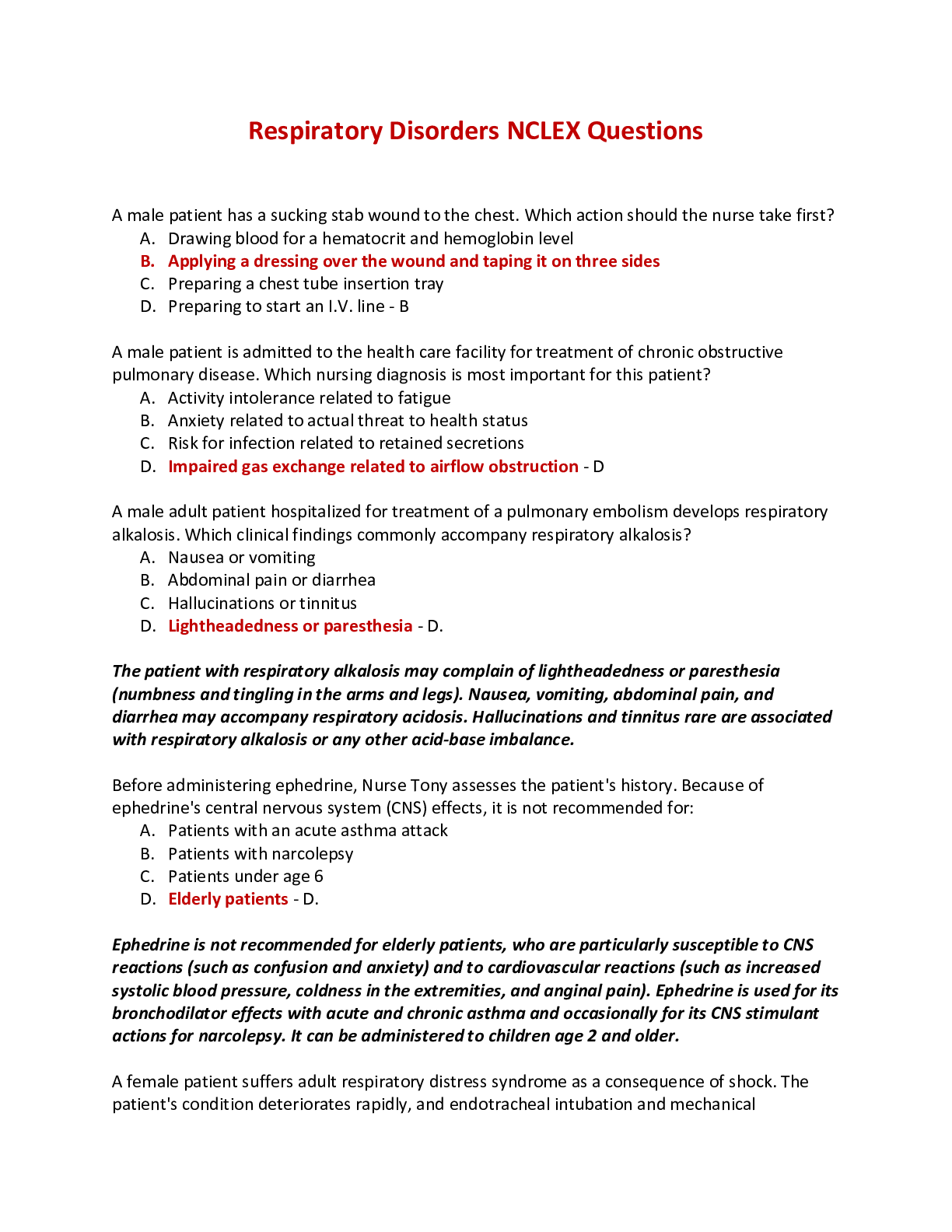
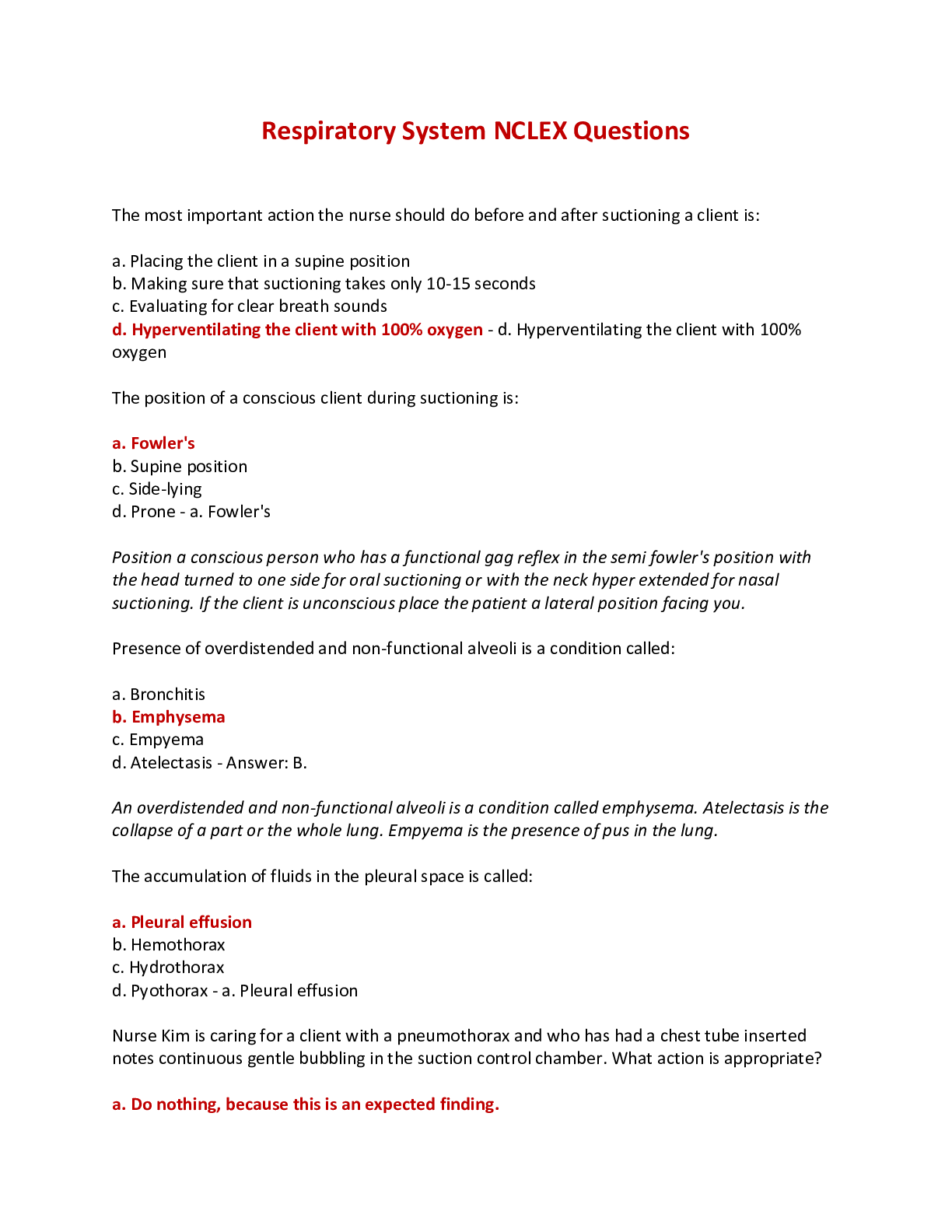
 NCLEX Study Guide.png)
